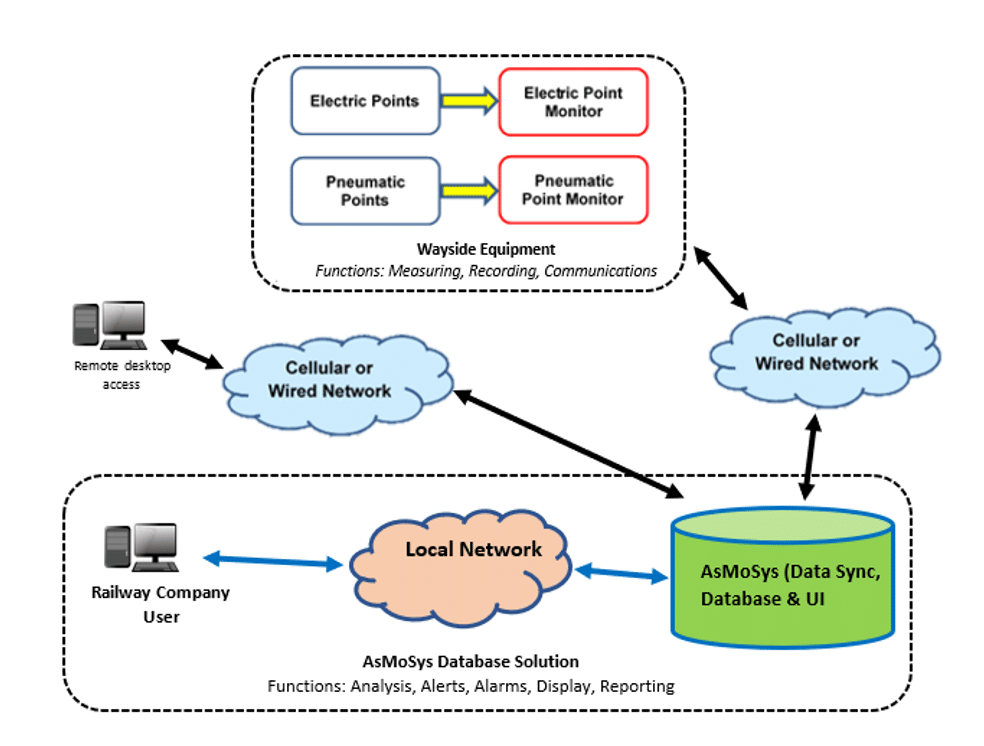Imagine if railway companies could monitor the health of the pneumatic and electric points along the tracks.
Imagine if they used a system that could help them keep an eye on point operations, identify maloperation and impending point failures, and alert railway network operators so that remedial actions can then be scheduled before a potentially catastrophic failure occurs.
Well, imagine no more, for such a solution exists. An Australian company, CHK Power Quality (CHK PQ) has developed a Points Condition Monitoring (PCM) system.
The company designs and manufactures power quality analysers, load loggers, transformer monitors and asset monitoring equipment.
The PCM system comprises three main sections, namely:
(1) data collection via the Miro Points PCM, from electric or pneumatic points
(2) a proprietary database called AsMoSys which collects data remotely from commissioned PCMs, initiates alarms and automatically transmits notifications to key personnel
(3) a user interface that enables end users to set up and commission PCMs, interrogate the database to view network status, reset alarms, and generate various performance reports.
As CHK PQ Sales Director Johnson Mariswamy explains, engineers can view PCM operation graphs and save them to a catalogue, with users able to create reports by selecting measurements for a specified time period to be displayed.
Set-up and configuration via Citrus
A critical part of the system is the proprietary software named Citrus, which can be used to communicate directly with the Miro PCM to download and view data, configure the PCMs, and upgrade firmware OTA (Over the Air).
Using Citrus, the user can quickly set up the PCM at the office, before deploying the PCM to site.
Training
Once installed and commissioned, every PCM is “trained” to monitor and characterise the normal operation of the point.
The trained PCM then monitors every point operation and determines if the operation is within allowable limits or ‘normal’.
If normal operation thresholds are exceeded, alarms are raised and notifications sent to relevant staff, e.g., signal engineers.
Email notifications include a graphic representation of the ‘abnormal’ operation, so staff can quickly identify the abnormalities, and deploy field staff with necessary materials to quickly rectify the problem.
AsMoSys database solution features
The AsMoSys database solution boasts multiple functions, including:
- Creation of new assets (eg. new set of points) and assigning a specific PCM to that asset
- Setting up and maintaining user logins and access levels
- Setting up training limits for approval and commissioning new point condition monitors
- Viewing the overall railway network, point locations and state of the points (Normal, Alarm, Alert). A ‘traffic light’ system allows easy identification of point status
- Drilling down to individual points to see how a point is performing and view operation trends
- Creating and maintaining event catalogues that users can refer to when trying to identify and understand point operation behaviour, faults, and peculiarities
- Creating multilevel reports (e.g., individual point, group of points or network wide), including operation trends and maintenance intervals.
PCM models

- The PCM-Electric is used with electrically driven point machines, with voltage and current inputs
- The PCM-Pneumatic is used with pneumatically driven point machines, with pressure and flow rate inputs
“The PCM-Electric is normally installed in a rail location cabinet (LOC) and not necessarily located close to the electric point/s, while the control cabinet containing the PCM-Pneumatic is installed on a metallic frame located close to the pneumatic point,” Mariswamy said.
The PCMs are equipped with remote cellular or Ethernet, for remote communications.
Reduction of capital, maintenance and operational costs
“The PCM allows railway operators to monitor point operation trends and optimise maintenance intervals,” Mariswamy said. “The trends include changes in point operation duration, load current and flow rate.”
He said the benefits of PCMs and the data it provides are manifold.
“These include improved operational statistics, reduced train disruption, optimised maintenance intervals, and subsequently minimised operational and maintenance costs,” he said.
“CHK PQ’s solution helps railway network operators to transition from a periodic maintenance regime to the more efficient condition-based maintenance regime. “There are also increased intangible benefits, for example, customer goodwill.”
The CHKPQ difference
CHK PQ’s technical expertise was recognised when it was recently awarded a long-term contract by a major NSW railway network owner and operator to supply, install, test and commission PCMs.
“Our mission is to enable customers to identify, monitor and resolve issues that will help optimise the performance and reliability of plant and equipment, thereby reducing operating costs. We do this by designing equipment that utilise innovative and modern technologies,” Mariswamy said.
He said organisations are becoming aware of the benefits of monitoring their equipment and reaping the benefits, which include:
- Avoiding penalty charges due to poor power factor
- Lowering electricity bills
- Extending the life of electrical equipment by monitoring, identifying, and resolving issues, before actual failures occur, thereby reducing capital costs
- Lowering ongoing plant maintenance costs
“We help customers monitor their power networks and assets to identify problem areas and provide cost-effective recommendations to improve the power quality of their power network and reduce life cycle costs by condition monitoring their assets,” Mariswamy said.
“We are passionate about power quality and condition monitoring. Our engineers are always seeking new and innovative technology, to develop products and analysis tools that help customers measure detailed power quality and critical asset parameters, analyse data, identify issues, and resolve them.
“We also provide consulting services where we can analyse the data and help home in on issues and suggest measures to mitigate or eliminate the issues identified.”
Mariswamy stressed the company’s commitment to excellence in before-and-after sales support, always treating customers with respect and responding to every query promptly and accurately.
“Our engineers are always ready to address any technical issues that may arise and provide prompt resolutions, and we are always working with customers to develop and implement new features, that will make the user experience a delightful one,” he said.




